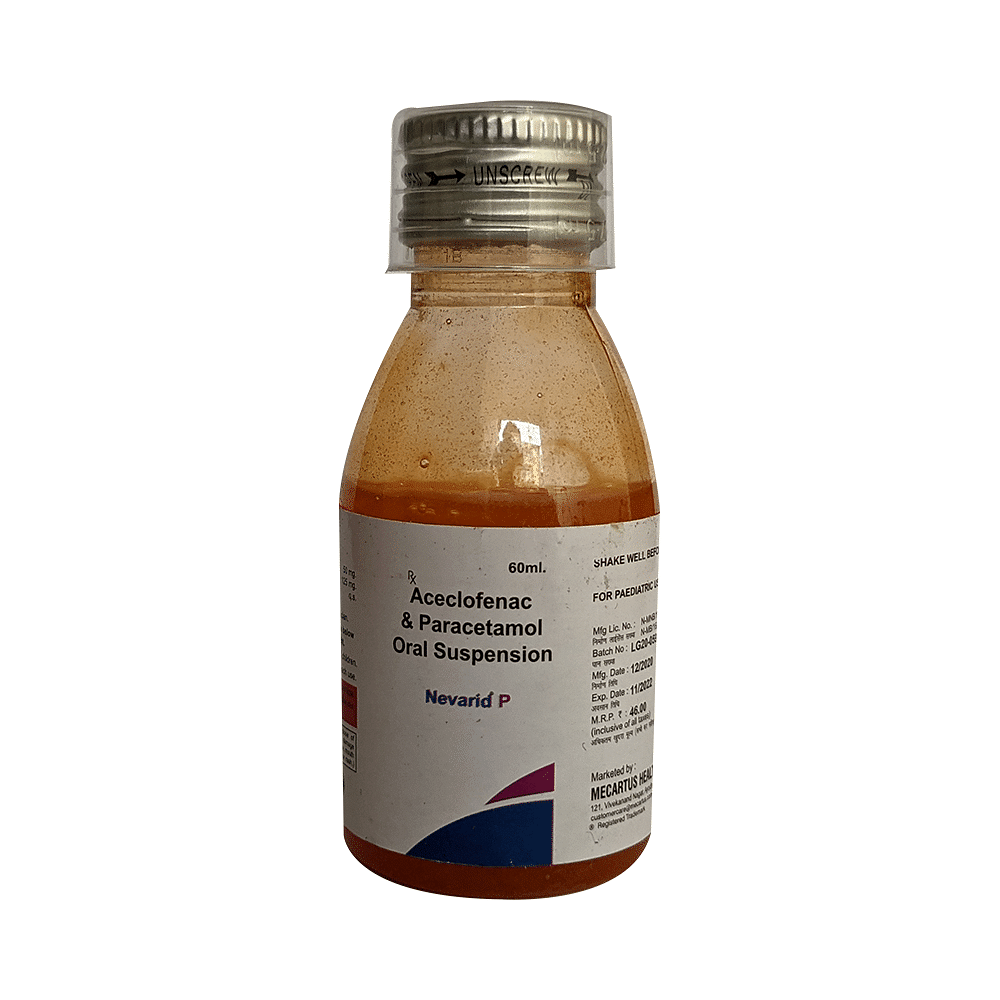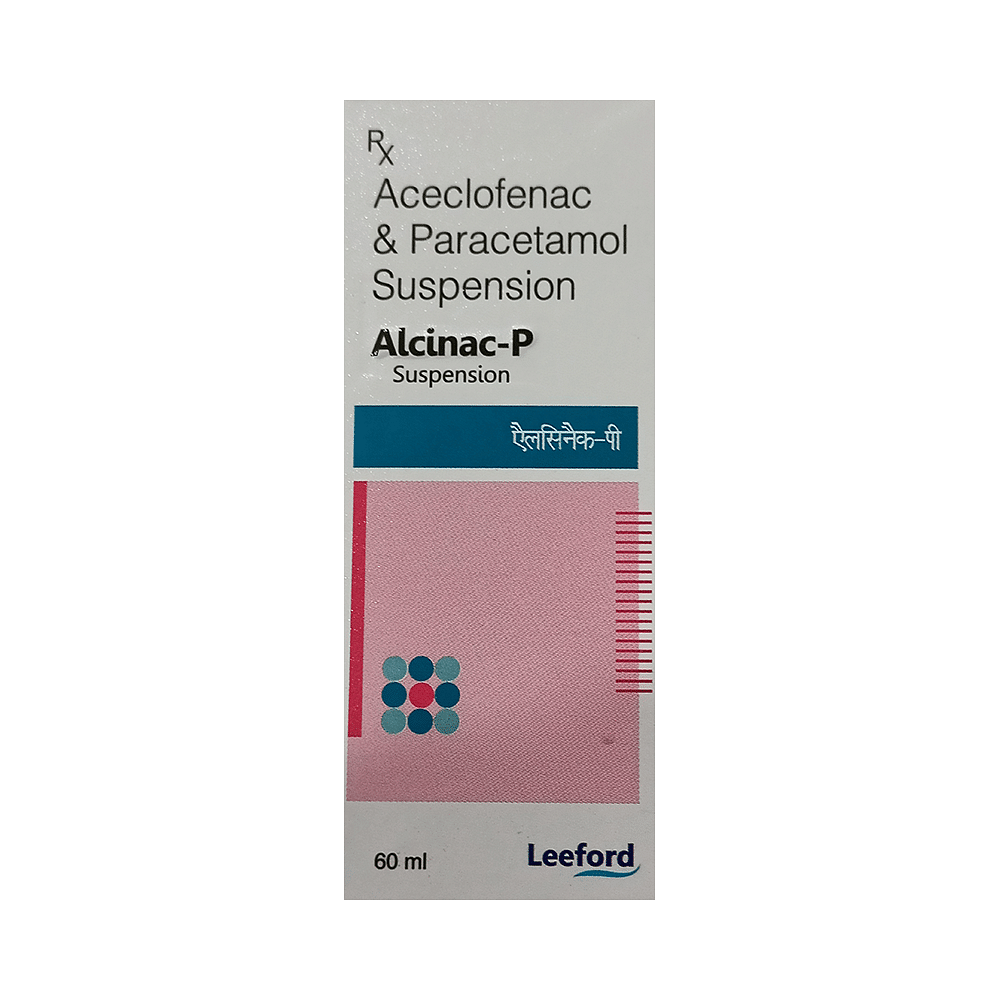
Aceomed P Oral Suspension
Manufacturer
Medliva Lifesciences
Salt Composition
Aceclofenac (50mg) + Paracetamol (125mg)
Key Information
Short Description
Aceomed P Oral Suspension helps lower body temperature (fever) and reduce pain and inflammation (redness and swelling) both in infants and children.
Dosage Form
Oral Suspension
Introduction
Aceomed P Oral Suspension is a medication that helps to lower body temperature (fever) and reduce pain and inflammation (redness and swelling) in infants and children. It is available in the form of an oral suspension.
Directions for Use
Give this medicine after food to avoid abdominal discomfort in your child. Maintain a log of your child's temperature. If you do not see any improvement, contact your child's doctor for advice.
How it works
Aceomed P Oral Suspension comprises two active ingredients: Aceclofenac and Paracetamol. These medicines work by blocking the action of chemical messengers responsible for pain, fever, and inflammation (redness and swelling).
Quick Tips
Give this medicine after food to avoid abdominal discomfort in your child. Maintain a log of your child's temperature. If you do not see any improvement, contact your child's doctor for advice. Keep a track of the dose and the frequency in which you have given this medicine to your child. This will help prevent overdosing. Practice self-care tips like giving plenty of fluids to your child, giving a balanced diet, encouraging optimum sleep, and stopping the medicine and consulting your child's doctor in case of allergic rash or stomach pain soon after taking this medicine.
Related Medicines

Zeonac Plus Oral Suspension

Nevarid P Oral Suspension

Acelopara Oral Suspension

Aceflec Oral Suspension

Acekyor-P Oral Suspension

Acetus Oral Suspension

Acezol P Oral Suspension

Aqnozone Oral Suspension

Ricnac P Oral Suspension

Alcinac-P Oral Suspension
Frequently asked questions
What is the recommended approach to adjusting the dose of Aceomed P Oral Suspension for my child?
It is not recommended to alter the dose of Aceomed P Oral Suspension without consulting a doctor. Increasing the dose may lead to toxicity, while decreasing it may cause recurrence of symptoms. For best results, consult your child's doctor if you feel a change in dose may be needed.
How should I administer the correct dose of Aceomed P Oral Suspension to my child?
Your doctor will prescribe the dose according to your child's condition and body weight. Stick to the prescribed dosing schedule as it is the best way to ensure the safe and complete recovery of your child.
Where should I store Aceomed P Oral Suspension?
Aceomed P Oral Suspension should be stored at room temperature, in a dry place, away from direct heat and light. Additionally, keep all medicines out of the reach and sight of children to avoid any accidental intake.
Can all children receive the same dose of Aceomed P Oral Suspension?
No, Aceomed P Oral Suspension cannot be given to everyone in the same dose. The doctor decides the appropriate dose based on the child's age and body weight. The dose may change for your child as they grow older. Always consult a doctor before giving any dose of this medicine to anyone.
What can I expect regarding my child's recovery timeline?
You may need to give Aceomed P Oral Suspension to your child for several days to weeks, depending on the severity of the infection. Continue to administer the medicine in the prescribed dose and frequency, and you should notice a reduction in pain or fever, leading to overall improvement.
What are some serious side effects I should be aware of when administering Aceomed P Oral Suspension to my child?
Although well-tolerated by children, if your child experiences persistent vomiting, body swelling, decreased urine frequency, or a serious allergic reaction while taking Aceomed P Oral Suspension, seek medical attention immediately.
Are there any specific contraindications for using Aceomed P Oral Suspension in my child?
The use of Aceomed P Oral Suspension is considered harmful for patients with known allergies to the components or excipients of this medicine, as well as those who are allergic to other painkillers (NSAIDs). It should be avoided in patients with a history of stomach ulcers, active recurrent stomach ulcer/bleeding, heart failure, high blood pressure, and liver or kidney disease.


